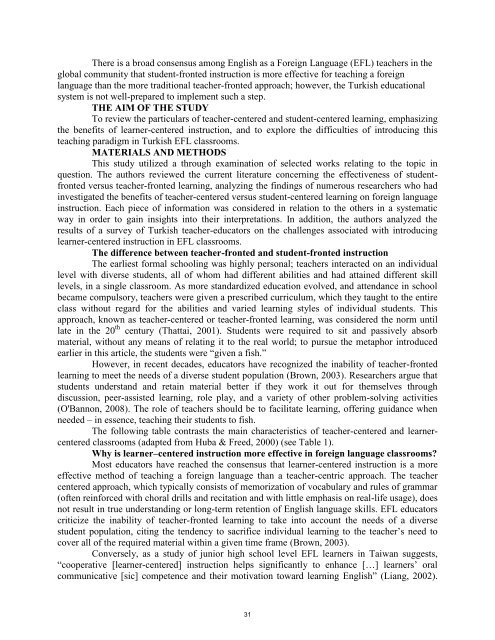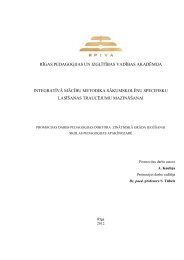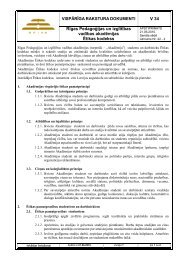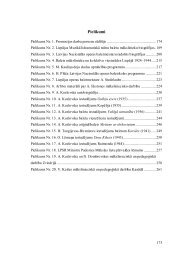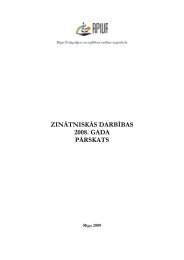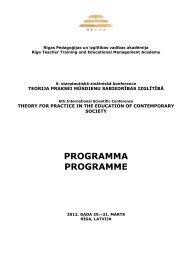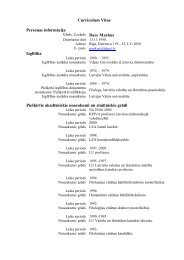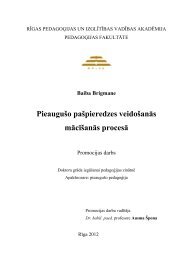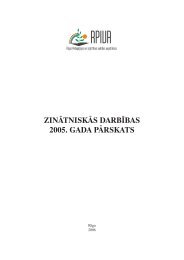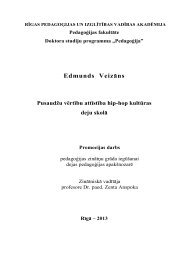saturs - rpiva
saturs - rpiva
saturs - rpiva
- No tags were found...
You also want an ePaper? Increase the reach of your titles
YUMPU automatically turns print PDFs into web optimized ePapers that Google loves.
There is a broad consensus among English as a Foreign Language (EFL) teachers in the<br />
global community that student-fronted instruction is more effective for teaching a foreign<br />
language than the more traditional teacher-fronted approach; however, the Turkish educational<br />
system is not well-prepared to implement such a step.<br />
THE AIM OF THE STUDY<br />
To review the particulars of teacher-centered and student-centered learning, emphasizing<br />
the benefits of learner-centered instruction, and to explore the difficulties of introducing this<br />
teaching paradigm in Turkish EFL classrooms.<br />
MATERIALS AND METHODS<br />
This study utilized a through examination of selected works relating to the topic in<br />
question. The authors reviewed the current literature concerning the effectiveness of studentfronted<br />
versus teacher-fronted learning, analyzing the findings of numerous researchers who had<br />
investigated the benefits of teacher-centered versus student-centered learning on foreign language<br />
instruction. Each piece of information was considered in relation to the others in a systematic<br />
way in order to gain insights into their interpretations. In addition, the authors analyzed the<br />
results of a survey of Turkish teacher-educators on the challenges associated with introducing<br />
learner-centered instruction in EFL classrooms.<br />
The difference between teacher-fronted and student-fronted instruction<br />
The earliest formal schooling was highly personal; teachers interacted on an individual<br />
level with diverse students, all of whom had different abilities and had attained different skill<br />
levels, in a single classroom. As more standardized education evolved, and attendance in school<br />
became compulsory, teachers were given a prescribed curriculum, which they taught to the entire<br />
class without regard for the abilities and varied learning styles of individual students. This<br />
approach, known as teacher-centered or teacher-fronted learning, was considered the norm until<br />
late in the 20 th century (Thattai, 2001). Students were required to sit and passively absorb<br />
material, without any means of relating it to the real world; to pursue the metaphor introduced<br />
earlier in this article, the students were “given a fish.”<br />
However, in recent decades, educators have recognized the inability of teacher-fronted<br />
learning to meet the needs of a diverse student population (Brown, 2003). Researchers argue that<br />
students understand and retain material better if they work it out for themselves through<br />
discussion, peer-assisted learning, role play, and a variety of other problem-solving activities<br />
(O'Bannon, 2008). The role of teachers should be to facilitate learning, offering guidance when<br />
needed – in essence, teaching their students to fish.<br />
The following table contrasts the main characteristics of teacher-centered and learnercentered<br />
classrooms (adapted from Huba & Freed, 2000) (see Table 1).<br />
Why is learner–centered instruction more effective in foreign language classrooms<br />
Most educators have reached the consensus that learner-centered instruction is a more<br />
effective method of teaching a foreign language than a teacher-centric approach. The teacher<br />
centered approach, which typically consists of memorization of vocabulary and rules of grammar<br />
(often reinforced with choral drills and recitation and with little emphasis on real-life usage), does<br />
not result in true understanding or long-term retention of English language skills. EFL educators<br />
criticize the inability of teacher-fronted learning to take into account the needs of a diverse<br />
student population, citing the tendency to sacrifice individual learning to the teacher’s need to<br />
cover all of the required material within a given time frame (Brown, 2003).<br />
Conversely, as a study of junior high school level EFL learners in Taiwan suggests,<br />
“cooperative [learner-centered] instruction helps significantly to enhance […] learners’ oral<br />
communicative [sic] competence and their motivation toward learning English” (Liang, 2002).<br />
31


